
The oud is a Middle Eastern short-neck lute-type, pear-shaped, fretless stringed instrument, usually with 11 strings grouped in six courses, but some models have five or seven courses, with 10 or 13 strings respectively.

The cittern or cithren is a stringed instrument dating from the Renaissance. Modern scholars debate its exact history, but it is generally accepted that it is descended from the Medieval citole. Its flat-back design was simpler and cheaper to construct than the lute. It was also easier to play, smaller, less delicate and more portable. Played by people of all social classes, the cittern was a popular instrument of casual music-making much like the guitar is today.

The Russian guitar (sometimes referred to as a "Gypsy guitar") is an acoustic seven-string guitar that was developed in Russia toward the end of the 18th century: it shares most of its organological features with the Spanish guitar, although some historians insist on English guitar descent. It is known in Russian as the semistrunnaya gitara (семиструнная гитара), or affectionately as the semistrunka (семиструнка), which translates to "seven-stringer". These guitars are most commonly tuned to an open G chord as follows: D2 G2 B2 D3 G3 B3 D4. In classical literature, the lowest string (D) occasionally is tuned down to the C.

The bandurria is a plucked chordophone from Spain, similar to the mandolin and bandola, primarily used in Spanish folk music, but also found in former Spanish colonies.
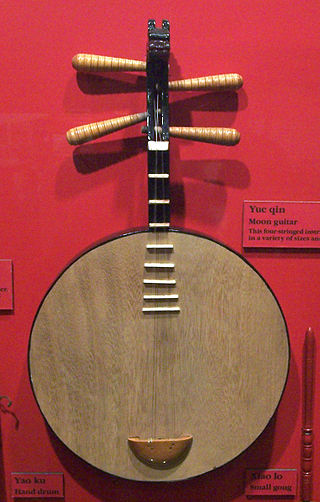
The yueqin, also called a moon lute or moon guitar, is a traditional Chinese string instrument. It is a lute with a round, hollow soundboard, a short fretted neck, and usually four strings. It is an important instrument in the Peking opera orchestra, often taking the role of main melodic instrument in lieu of the bowed string section.

The name chillador can refer either to two related types of charango. The First type, simple called chillador is a type of charango which has a flat back and is usually steel-strung. It exists in both 10-and 12-string forms. When strung with 10-strings it is tuned the same as a charango. With 12 strings, courses 2 and 4 are triple-strung, and the (re-entrant) tuning is more like that of a charangon or ronroco in Argentine tuning. The chillador charango is a standardly-tuned charango but with a body built from bent sides and a flat back like a (smaller) guitar,
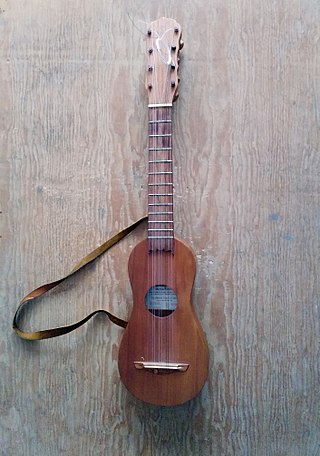
The jarana jarocha is a guitar-shaped fretted stringed instrument from the southern region of the state of Veracruz, Mexico. Typically strung with 8 strings in 5 courses, usually arranged in two single outer strings with three double-courses in between. The strings are usually nylon, although they were gut in the past. The body is somewhat narrower than a guitar because of its direct lineage from the Spanish baroque guitar of the sixteenth century. Sometimes mistaken for a ukulele, the jarana jarocha comes in at least five sizes, the smallest being the chaquiste, somewhat smaller than a soprano ukulele; then the mosquito, about the size of a soprano ukulele; the 'primera', about the size of a concert ukulele; the 'segunda', in length between a tenor and a baritone ukulele; and the 'tercera', somewhat longer than the baritone ukulele. Some luthiers are building jaranas of a size they label "tercerola" or "jarana cuarta", but there is some discussion as to whether these represent a distinct size or are merely particularly large variations of the standard tercera.
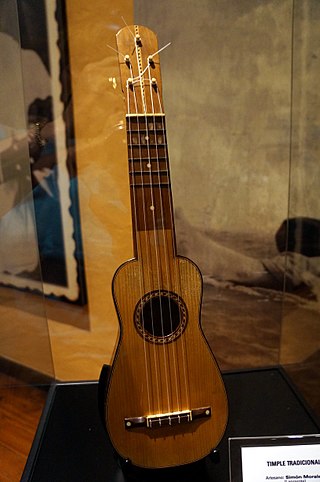
The timple is a traditional five-string plucked string instrument of the Canary Islands. It started being manufactured in the 19th century.
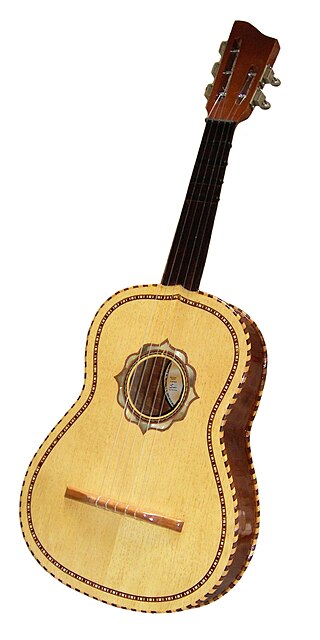
The Mexican vihuela is a guitar-like string instrument from 19th-century Mexico with five strings and typically played in mariachi groups.

The dramyin or dranyen is a traditional Himalayan folk music lute with six strings, used primarily as an accompaniment to singing in the Drukpa Buddhist culture and society in Bhutan, as well as in Tibet, Ladakh, Sikkim and Himalayan West Bengal. It is often used in religious festivals of Tibetan Buddhism. The instrument is played by strumming, fingerpicking or plucking. The dramyen, chiwang (fiddle), and lingm (flute) comprise the basic instrumental inventory for traditional Bhutanese folk music.
This is a chart of stringed instrument tunings. Instruments are listed alphabetically by their most commonly known name.
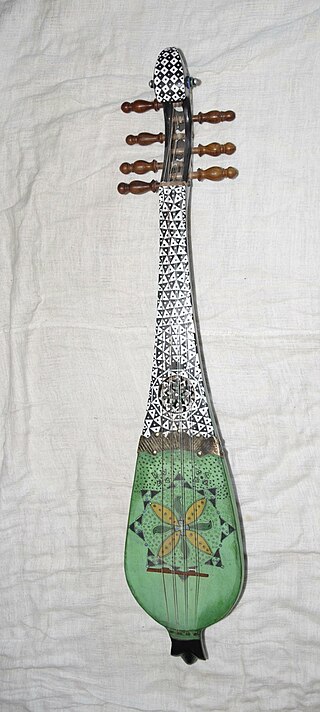
A qanbūs is a short-necked lute that originated in Yemen and spread throughout the Arabian peninsula. Sachs considered that it derived its name from the Turkic komuz, but it is more comparable to the oud. The instrument was related to or a descendant of the barbat, a (possibly) skin-topped lute from Central Asia. The qanbūs has 6 or 7 nylon strings that are plucked with a plectrum to generate sound. Unlike many other lute-family instruments, the gambus has no frets. Its popularity declined in Yemen during the early 20th century reign of Imam Yahya; by the beginning of the 21st century, the oud had replaced the qanbūs as the instrument of choice for Middle-Eastern lutenists.

Laúd is a plectrum-plucked chordophone from Spain, played also in diaspora countries such as Cuba and the Philippines.

The Puerto Rican cuatro is the national instrument of Puerto Rico. It belongs to the lute family of string instruments, and is guitar-like in function, but with a shape closer to that of the violin. The word cuatro means "four", which was the total number of strings of the earliest Puerto Rican instrument known by the cuatro name.

The English guitar or guittar is a stringed instrument – a type of cittern – popular in many places in Europe from around 1750–1850. It is unknown when the identifier "English" became connected to the instrument: at the time of its introduction to Great Britain, and during its period of popularity, it was apparently simply known as guitar or guittar. The instrument was also known in Norway as a guitarre and France as cistre or guitarre allemande. There are many examples in Norwegian museums, like the Norsk Folkemuseum and in British ones, including the Victoria and Albert Museum. The English guitar has a pear-shaped body, a flat base, and a short neck. The instrument is also related to the Portuguese guitar and the German waldzither.

The viola amarantina is a stringed musical instrument from Amarante, Northern Portugal. It is also named viola de dois corações because of the two heart-shaped frontal openings. It has 10 strings in 5 courses. The strings are made of steel. It is tuned A3 A3, F# F#, B2 B3, G2 G3, D2 D3.
The halszither is a stringed instrument from Switzerland. It has nine steel strings in five courses and is tuned: G2, D3 D3, G3 G3, B3 B3, D4 D4.
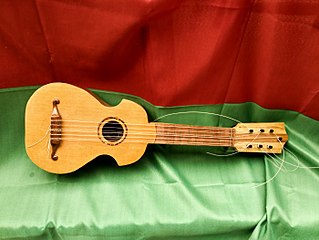
The khonkhota or ponputu is a stringed instrument from San Pedro de Buenavista, Potosí, Bolivia. It is now played in much of the surrounding region also. It has flowers decorating the soundboard, which symbolise fertility. The name roughly translates as harmonics, and it often only has five frets, which alternate between black and white wood. It is usually very rustically made.
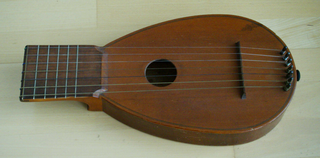
The Stoessel lute is a string instrument invented by Georg Stössel in 1914 in Cologne (Köln), Germany. Its steel strings are fingered not by putting one's hand round the neck, but over the end of it. To this end, most Stössel lutes have very short necks. It is, in effect, a hybrid between a necked string instrument and a zither.
The Guitarra chamula is a stringed instrument from San Juan Chamula, Chiapas, Mexico. It has 10 or 12 metal strings of all the same thickness in 4 courses, with a tuning of aaa d'd'd' bbb e'e'e'. It is used traditionally within local festivals together with a Mexican harp and a harmonica.

















